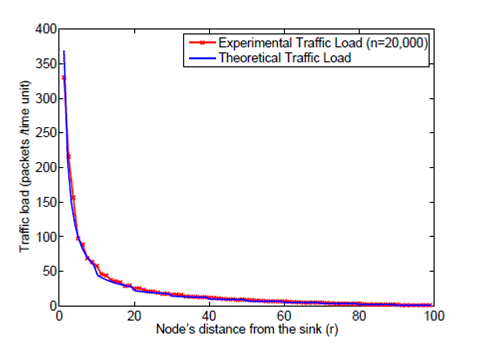Abstract
Wireless sensor networks have become popular these days due to their in terms of electronics, information processing and networking advancements. There are many applications across the Wireless Sensor networks and few of them are Health monitoring, forecasting and information processing.
There is lot of research done on the Wireless Sensor networks and there are few areas to be concentrated more the mainly the Traffic analysis, energy consumption and anomaly detection. This project helps in modeling the traffic analysis in various aspects like sequence relations among the packets that are being arrived, defining and modeling the traffic arrival rates across the WSN and load distribution of traffic across WSN.
This project proposes a technique to handle the network performance issues across the energy resource allocation process. An optimized energy allocation scheme is proposed in this project. Anomaly detection is done as per the traffic analysis across WSN. Main aim of this project is to consider three important problems in Wireless sensor networks and propose a solution to them.
One among these problems is to analyze the traffic caused by the incoming packets and model the traffic and also to model the sequence relationship among the arriving packets. Network optimization is also proposed based on the energy efficient resource allocation across the wireless sensor networks and finally to detect the anomalies based on the analyzed traffic.

Conclusion and future work:
Wireless Sensor networks are widely used across many real time applications and due to their demand they are widely accepted and integrated across every organization these days. In most of the applications all the deployed sensor nodes are inexpensive and all combined to act as a corporate network. Even though WSN is a good technology, there are some technical loop holes in the technology and there is lot of research done to overcome these limitations.
Most of the traffic dynamics in WSN technology are application dependent and there is no perfect traffic analysis model across WSN. In this project, It have done all the basic research on traffic analysis and modeling across WSN and proposed few optimization solutions for a perfect analysis and modeling sequence of traffic.
A window based scanning process is completely evaluated in this project to measure sequence relations among the arriving packets at individual sensors and all the sequence of packet arriving rates are mapped a character string to identify the exact sequence of packets and this character string can be used in perfect analysis and modeling of packets.
A typical ON/OFF model is used to measure the bursty traffic sequences. For better understanding the traffic dynamics, network optimization techniques are always required.
By traffic dynamics understanding WSN optimization research is activated. By designing WSN performance and energy consumption, communication traffic interrelation ship, information about energy consumption in network will be gathered and by energy resources availability performance investigation is preceded.
For correct deployment and future routing investigation results are useful. To minimize energy waste and maximized network life time optimized energy scheme is proposed by utilizing knowledge of symmetric dense WSN traffic load distribution.
When compared to internet which is traditional network, WSN traffic patterns are less dynamic and simple and this statement is derived by using research knowledge of traffic modeling and analysis.
By this information for whole network and individual nodes precise traffic profile is built because WSN normal traffic operations generate traffic which follow profiles of normal traffic and signals of normal traffic profile violated by irregularity.
In network optimization future work, limited resource inherent nature has high importance. In network processing node mobility bounds of fundamental performance are not clear. To verify WSN fundamental performance bounds, optimization model for network is designed and pre conditions of traffic model are option.
By centralized coordination algorithms optimal performance is achieved without network processing and mobility. So, for real implementation search is focused on distribution coordination algorithms development. For optimal energy for WSNs optimal resources are allocated. So, resources allocation development will be useful in WSN scenarios.
WSN anomaly detection will be very important in WSN by that for real deployment is available in WSN. In WSN anomaly detection packet traffic is necessary but it requires some support. In WSN alarm rates of high false are not acceptable and low probability events are malicious attacks. With alarm rates low false, anomaly detection system designing is hard.
When any problem is detected in network, detecting and recovering from that problem is necessary and some measures should be performed to recover from damage. In WSN future anomaly detection, emergency response strategies development will be need.

I am greatfull to you for giving information